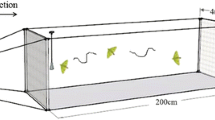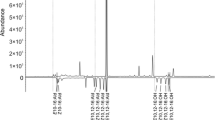Summary.
Females of both species start their pheromone-releasing activity on the second day after emergence at the beginning of the photophase. During the present work, a peak of calling activity with close to 100% of active Ph. nigrescentella females was registered 1.5 hour after the light had been put on. The high pheromone release behaviour with 50% active females lasted for 3 hours. The calling activity of the group of females was about 6 h/day. The beginning of a photophase under laboratory conditions or an early morning in nature is a common period for sex pheromone release in the genus Phyllonorycter. (8Z,10E)-tetradecadien-1-yl acetate (8Z,10E-14:Ac), (8Z,10E)-tetradecadien-1-ol (8Z,10E-14:OH) and (8E,10Z)-tetradecadien-1-yl acetate (8E,10Z-14:Ac) in the ratio 96:4:traces as well as 8Z,10E-14:Ac and 8Z,10E-14:OH in the ratio 88:12 collected by Solid Phase Micro Extraction (SPME) were found to be specific for the calling periods of virgin Phyllonorycter insignitella and Ph. nigrescentella females respectively. Field trapping experiments demonstrated that all three compounds are important for the attraction of Ph. insignitella males while only 8Z,10E-14:Ac is the essential sex pheromone component for Ph. nigrescentella. The pheromone activity of all three compounds is reported for the first time. Addition of either 8Z,10E-14:OH or 8E,10Z-14:Ac to 8Z,10E-14:Ac did not have a significant effect on the attraction of Ph. nigrescentella males, while the efficiency of the three component blend was 5 times lower as compared to that of 8Z,10E-14:Ac. Our data demonstrate that 8Z,10E-14:OH and 8E,10Z-14:Ac play a dual function, they are minor sex pheromone components of Ph. insignitella essential for attraction of conspecific males and show an allelochemical, antagonistic effect on Ph. nigrescentella males and, thus, ensuring specificity of the mate location signal in two related Phyllonorycter species.
Similar content being viewed by others
Author information
Authors and Affiliations
Corresponding author
Rights and permissions
About this article
Cite this article
Mozūraitis, R., Liblikas, I. & Noreika, R. Sex pheromone communication of tentiform leaf-miners Phyllonorycter insignitella and Ph. nigrescentella from two related species groups. Chemoecology 18, 171–176 (2008). https://doi.org/10.1007/s00049-008-0400-9
Received:
Accepted:
Published:
Issue Date:
DOI: https://doi.org/10.1007/s00049-008-0400-9




